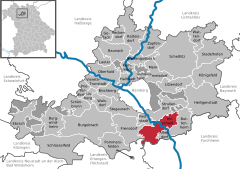Hirschaid
Hirschaid lies not far from the former via regia, an ancient road that since antiquity joined the north in the area around Lüneburg with the south all the way to Lower Austria.
Finds dug up on the Regnitz Valley terraces bear witness to an early settlement beginning no later than the New Stone Age.
Bearing witness to the later La Tène culture (Celtic) are above all the finds and wall remains on the nearby Friesener Warte In 1079, Hirschaid became historical for the first time through a document issued by King Heinrich IV.
The coat of arms that they bore then, showing a golden hart in silver climbing out of a blue three-knolled hill (a charge called a Dreiberg in German heraldry), foreshadowed the one now borne by the community.
The building of the Ludwig Danube-Main Canal in 1834 and the opening of the Nuremberg-Bamberg railway line in 1844 yielded the first industrial incentives for Hirschaid.

